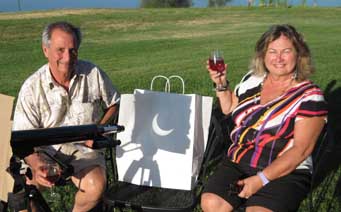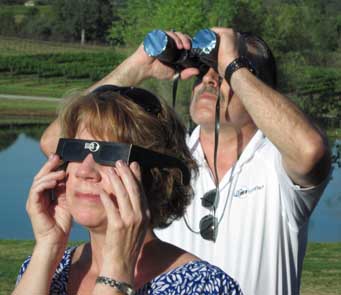
Here's a perfect mix: watching the Sun and Moon meet overhead while sipping a fine vintage at an idyllic California winery.
This was my sixth "ring" eclipse of the Sun. Past ones had taken me to sunny Spain and soggy Scotland and even onto an airplane I'd chartered at the last minute off the Pacific Coast. Yesterday's event had a decidedly closer-to-home feel, as the path from which one could see a "ring of fire" passed near the California home of my brother John. A two-hour hop past Sacramento would position us perfectly. There was never any question that my wife, Cheryl, and I would fly out from Boston to see it.
In truth, I needed to take this trip to settle a debt. In 2003 John and my sis-in-law Michele had accompanied us to the Isle of Lewis in northern Scotland. There I'd hoped to catch the dazzling merger of Moon on Sun over the amazing ring of standing stones at Callanish. The evening before had been crystal clear, but the big day dawned with a relentless downpour. Bummer.
This time around, I decided to indulge a modest fantasy: to view it from the Sun-splashed patio of a really good California winery, with a glass of 2007 zinfandel in one hand and my telescope's focus knob in the other.
I succeeded, mostly: the wine turned out to be a 2010 Sangiovese.
Finding a good winery was easy. After a thorough search I'd settled on Naggiar Vineyards, a family-owned estate in Grass Valley. It was also situated just a couple of thousand feet inside the path's southern limit. This choice, as I'd learned in Spain, would be too near the limit to see the complete annular ring by eye, but I was drawn there by the lure of extended Baily's beads and Naggiar's reputation for killer reds.

Mike and Diane Naggiar, the friendly owners of Naggiar Vineyards, offer a toast
during an impromptu gathering of family, staff, and friends during the May 20,
2012, annular eclipse. Between them is an image of the eclipsed Sun projected
by Diane's 60-mm refractor.
(Credit: J. Kelly Beatty)
Our two-car caravan (wife, brother, sister-in-law, niece, and nephew in tow) arrived unannounced about an hour before the Moon and Sun's first contact, and we quickly introduced ourselves to owners Mike and Diane. My immediate problem was that the winery closed at 5 p.m., yet we wouldn't experience the mid-eclipse ring until 6:30 — actually 6:31:08.4, but who's counting? Fortunately, they loved the idea, and soon we started hauling gear out of my car's trunk as the Naggiars started rounding up family, friends, and staff.
After two decades of eclipse-driven globetrotting, I've got my mobile observing "kit" perfected. I'd brought two telescopes -- a small refractor for viewing and a slightly larger reflector for photography -- along with two binoculars and a fistful of "eclipse glasses" for other guests.
The day was beautifully clear and a bit warm. In fact, clear skies prevailed along the entire U.S. portion of the path, with the exception of clouds along the California coast and a pocket of storms along the northern border of New Mexico and Texas. By the time the Moon first nibbled on the Sun's disk, we'd assembled a gaggle of about 30 eager onlookers. Diane even resurrected a rickety old telescope from a closet and brought it to the gathering on a golf cart.
The eclipse had been under way less than 30 minutes when I noticed the change in the surrounding daylight -- sooner than I expected but unmistakable: a perceptible dimming, crisp shadows, and that unique silvery quality that I'd seen before. As we neared the eclipse's climax, the temperature dropped noticeably, by maybe 10°. I flitted between snapping images of the Sun's shrinking disk and working the crowd: explaining why eclipses happen, pointing out the changing shadows, and showing kids how to make little crescents by letting bits of sunlight stream through their crossed fingers.
I knew the complete annulus would be fleeting telescopically and unobservable visually. Even straining at the eyepiece of my telescope, I'm still not sure that I saw a complete ring.
But neither I nor the onlookers really cared. The wine was flowing freely, and plates of prosciutto, cheese, and sauteed shrimp had materialized from the kitchen. Many had somehow not known the eclipse was going to occur, and everyone buzzed with giddy excitement. I was in my element. I love showing off the sky and explaining -- to anyone who'll listen, actually -- how the clockwork of the solar system works.
For example, there's a link between the so-called "Supermoon" two weeks ago and yesterday's ring of fire. The former occurred because the Moon was full just as it came closest to Earth in its slightly out-of-round orbit. Yesterday's new Moon (which is when all solar eclipses happen) came half an orbit later, with the Moon its farthest from Earth. The difference in distance, just 31,000 miles, was enough to put the Moon too far away to completely cover the Sun yesterday.

Two novice skywatchers enjoy the annular solar eclipse on May 20, 2012.
(Credit: J. Kelly Beatty)
All too soon it was time to go. We'd transformed a lazy Sunday afternoon into a festive gathering, but we were careful not to overstay our welcome. So we packed up, thanked the Naggiars for their hospitality, and hit the road long before what astronomers call "fourth contact" — when the last hint of the lunar silhouette slips off the Sun's disk.
The one little "cloud" in all of this was how poorly the news media performed in the run-up to the event. Too many stories showed pictures of total solar eclipses instead of annulars. Confusion abounded as what you'd see from within the path versus elsewhere. At least they all emphasized the danger of looking directly at the Sun.
If there was this much media buzz over a ring eclipse (which I'll admit is really just a partial eclipse under very special circumstances), I can only imagine what the "Big One" five years' hence will bring. On August 21, 2017, the Moon's shadow will sweep coast-to-coast across the continental U.S. It'll be the first total solar eclipse visible from the Lower 48 since 1979, and what a party that will be.